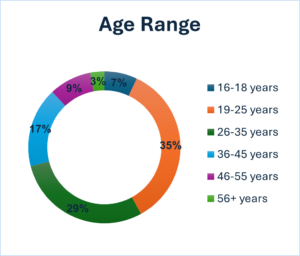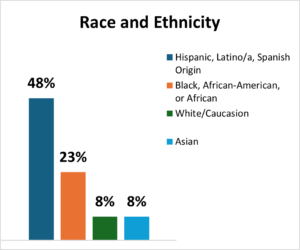By Natasha Bryant and Verena Cimarolli
LeadingAge researchers are evaluating a training program for certified nursing assistants and home health aides. Here are some preliminary findings.
As of August 1, 2024, 2,413 students have graduated from The Gateway-In Project©, a three-year LeadingAge California initiative to address critical shortages in the clinical workforce. The program actively recruits, trains, and provides employment for new certified nursing assistants (CNA) and home health aides (HHA) across California.
Enrollment data from LeadingAge California highlight the program’s successes to date. For example:
- Most program graduates (82%) are now trained as CNAs. Smaller percentages are trained as HHAs (6%) or trained as both CNAs and HHAs (13%).
- Most (95%) of the 1,448 students who reported their CNA certification status passed the state certification exam.
- Notably, 1,194 of the 1,371 students who passed their certification examination did so on their first attempt.
WHAT IS THE GATEWAY-IN PROJECT©?
The Gateway-In Project© began on July 1, 2022, and will conclude on June 30, 2025. The initiative was made possible by a $25 million grant awarded to LeadingAge California by the California Department of Health Care Access and Information. The LeadingAge LTSS Center @UMass Boston is conducting an in-depth evaluation of the program.
The project helps participants join the clinical workforce by:
- Paying tuition and fees for education and training.
- Providing wraparound supports, including childcare, transportation, food, and related training costs, to reduce barriers that many prospective students may face.
- Helping graduates pass their state certification exams and find jobs.
- Offering retention bonuses to graduates who are employed for one, six, and 12 months.
STUDENT PROFILE
According to enrollment data collected by LeadingAge California, The Gateway-In Project© students are primarily women, non-White, and between the ages of 19 and 35. Key demographic characteristics include:
- Gender: 85% of students are female.
- Age: 64% of participants are aged 19 to 35, while 20% fall within the 36-45 age range.
- Ethnicity and Race: Nearly half of the students identify as Hispanic (48%), and 23% are Black or African American.
- Marital and Family Status: Almost three-quarters of the students are single, while 14% are married. Half the students don’t have children, and 28% have two to four children.
- Education: 70% of students have a high school diploma, while 11% have some high school education.
- Income: Income levels are notably low, with 60% of students reporting a household income of less than $25,000. One-quarter of participants have a household income between $25,000 and $50,000.


CAREER ASPIRATIONS AND GOALS
The LTSS Center conducted a pre-training baseline survey with 413 students who enrolled in the second year of The Gateway-In Project© from September 2023 through February 2024. The survey provided insights into these students’ career development goals. Findings shed light on how students view their roles in the home and community-based services field and their goals for the future.
LTSS Roles:
- 61% of respondents said they view their CNA/HHA role as a stepping stone in their career journey.
- 38% view their CNA/HHA role as a career.
- 2% regard their CNA/HHA jobs only as a way to make money.
Goals for the Future:
- 82% of respondents expressed interest in furthering their education beyond a CNA/HHA certification.
- 76% want to advance in the nursing field.
NEXT STEPS FOR THE EVALUATION
After completing data collection in June 2025, LTSS Center researchers will focus their assessment on the value of the wraparound services The Gateway-In Project© offers students and the retention bonuses that program graduates receive for program completion and continued employment.
